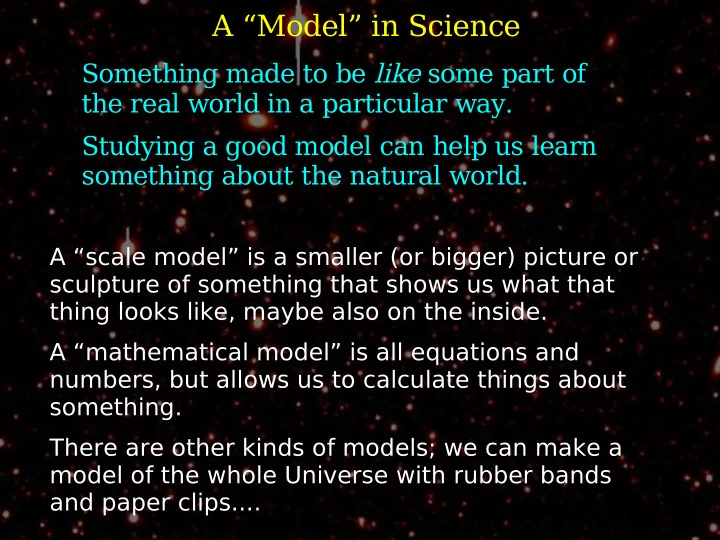

A “Model” in Science Something made to be like some part of the real world in a particular way. Studying a good model can help us learn something about the natural world. A “scale model” is a smaller (or bigger) picture or sculpture of something that shows us what that thing looks like, maybe also on the inside. A “mathematical model” is all equations and numbers, but allows us to calculate things about something. There are other kinds of models; we can make a model of the whole Universe with rubber bands and paper clips....
A “uniform” expansion Change in Distance = Constant Distance The greater the initial distance, the greater the change in distance.
With galaxies, how can we measure “change in distance”? 60 miles 110 miles Final Distance = 110 miles Start Distance = 60 miles Change in Distance = 110 – 60 miles = 50 miles Speed = 50 miles / 1 hour = 50 miles per hour Speed = Change in Distance Time
The “Hubble Diagram” of Galaxies Moving Away From Us Chagne in Distance (in one second) Distance
Note: the next few slides can be used if there is extra time, or if questions come up that could benefit from them.
The ultimate (unattainable?) “Truth” goal: What is nature? When do we consider a theory “right?” THEORY : a quantitative and descriptive framework that explains a set of natural phenomena and successfully describes the results of experiments or observations about the natural world. When is a model Experiments test enough to be called a theory? models, or models explain experiments Model Results of an experiment Experimental Result or observing program Truth via processing/analysis/interpretation of data, understanding uncertainties, etc. Individual observation Experimental or piece of data Fact Design
“Theoretically Impossible” = not possible in principle given our best current understanding of nature This is a stronger statement than “you think it can't be done”. Example : for a red light to look green, you must be going 100 million mph. This is impossible for any car available right now... but is perfectly possible in principle. It is theoretically impossible for anything to go faster than 670 million mph, the speed of light. (See also “slides on science & religion”)
Movies showing the expansion of the Universe as a 2d model. 1 2 3
A galaxy twice as far away increased its distance twice as much. The Milky Way Every Point is the Center!
Normal Matter What is the Universe Made Of? Dark Matter Dark • Normal Matter: Stars, Energy Nebulae, You • Dark Matter: Strange stuff with normal gravity. • Dark Energy: Stranger stuff with strange gravity that makes the expansion speed up.
Note: the remaining slides are more advanced, and should probably only be used in presentations to more advanced (high school?) students or to teachers.
A model 2-d closed Universe: the surface of a sphere North/South East/West
Somewhere Else Distance Between Galaxies Us
Points to notice • As the Universe expands, galaxies get farther apart, but... • ...galaxies are not moving through space ** • Galaxies don't expand themselves • A second galaxy that is farther away from a first galaxy looks like it's moving faster than one that's closer. • This works just like paper clips on a rubber band.
How Fast Is The Universe Expanding? The Virgo Cluster Map by Jan Wisniewski Distance today: 20 Mpc (million parsecs) Distance in 100 years: 20 Mpc + 1 ten millionth of a Mpc.
“Look-back” time to Virgo Cluster: 1 parsec = 3.26 light-years Light goes 1 light-year in one year (surprise!) 20 million parsecs means we see the Virgo clutser as it was 65 million years ago. Can we find something that has expanded along with the Universe over that time???? Yes! Light!
= 4500 Å The Wavelength ( ) of Light. Blue Light stretches along with the Universe = 7000 Å Red Light = 11,000 Å = 1.1 µ m Near-Infrared Light
REDSHIFT Wavelength Now Wavelength when light was emitted Amount of Universe Expansion: Distance Now Distance when light was emitted Cosmological Redshift – the two are the same!
Size at Light Emission Size Today Measuring the Expansion • Measure distance to get “lookback time” (how long the light took to reach us) • Measure redshift to get The Future??? amount of expansion over 1.0 that time. 0.5 Today The Big Bang Back in time Forward in time
Lookback Times Object Lookback Time Sun 8 minutes Alpha Centauri 4 years Andromeda Galaxy 2 million years Seyfert Galaxy NGC1068 16 million years Quasar 3C273 2 billion years at z=0.158 Galaxy at who emitted 7 billion years light at half the wavelength we see Age of Universe 13 billion years
Accelerating Size Universe Low-mass Size Today Universe Critical Mass Speeding up! Universe 1.0 Slowing down High-mass a little Universe 0.5 Slowing down a lot Today Years in the Past t Years from Today
Recommend
More recommend